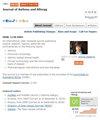通过过敏原特异性血清 IgE 抗体检测发现的华中地区疑似过敏性疾病儿童的过敏原来源
IF 3.7
3区 医学
Q2 ALLERGY
引用次数: 0
摘要
目的:尽管儿童过敏性疾病呈上升趋势,但目前尚未对华中地区过敏性疾病患儿的过敏原进行全面调查。因此,我们旨在分析华中地区过敏性疾病患儿血清过敏原种类的分布情况,为儿童过敏症的预防、诊断和治疗提供参考:共有 9213 名儿童(男性 5543 名,2.88±0.04 岁;女性 3670 名,2.91±0.05 岁)接受了过敏原筛查,并使用自动荧光酶免疫分析系统检测了血清过敏原特异性 IgE(sIgE)抗体:我们的研究结果表明,sIgE 阳性率(sIgE-PR)为 57.83%,其中混合食物(42.10%)、蛋清(30.83%)、牛奶(28.97%)、混合尘螨(24.57%)和混合霉菌(23.20%)是最普遍的过敏原来源。常见过敏源的 sIgE-PR 显示出显著的性别差异,男性的易感性高于女性(p< 0.05)。尘螨是吸入性过敏原的主要来源,而蛋白则是食物过敏原的主要来源。食物过敏原的来源在婴儿(0-3 岁)中最主要;大多数食物过敏原来源的 sIgE-PRs 随着年龄的增长而降低,而大多数吸入过敏原来源的 sIgE-PRs 则随着年龄的增长而升高。秋季混合霉菌、杂草花粉组合和树木花粉组合的 sIgE-PRs 明显高于其他季节(p< 0.05):我们的研究结果表明,不同年龄组和不同季节过敏儿童的过敏原来源各不相同。关键词:过敏原;儿童过敏;IgE抗体;食物过敏原来源;过敏预防本文章由计算机程序翻译,如有差异,请以英文原文为准。
Sources of Allergens Detected Through Allergen-Specific Serum IgE Antibody Test in Children with Suspected Allergic Diseases in Central China
Purpose: Although allergic diseases in children are on the rise, there has been no comprehensive investigation of the allergens affecting children with allergic diseases in central China. Therefore, we aimed to analyze the distribution of serum allergen species among children with allergic conditions in central China to inform the prevention, diagnosis, and treatment of childhood allergies.
Patients and Methods: A total of 9213 children (5543 males with 2.88 ± 0.04 years old and 3670 females with 2.91 ± 0.05 years old) underwent allergen screening, and serum allergen-specific IgE (sIgE) antibodies were detected using an automated fluorescent enzyme immunoassay system.
Results: Our findings revealed a total sIgE-positive rate (sIgE-PR) of 57.83%, with mixed food (42.10%), egg whites (30.83%), milk (28.97%), mixed dust mites (24.57%), and mixed molds (23.20%) being the most prevalent source of allergens. The sIgE-PR for common sources of allergens exhibited significant sex-based differences, with males having greater susceptibility than females (p< 0.05). Dust mites were the primary source of inhaled allergens, whereas egg white was the predominant source of food allergens. Sources of food allergens were most dominant among infants (0– 3 years old); sIgE-PRs for most source of food allergens decreased with age, whereas those for most source of inhaled allergens increased. The autumn sIgE-PRs for mixed molds, weed pollen combinations, and tree pollen combinations were significantly higher than those found in other seasons (p< 0.05).
Conclusion: Our findings suggest that sources of allergens profiles in children with allergies vary across age groups and seasons. Understanding these patterns can improve the effective prevention of childhood allergies.
Keywords: allergen, childhood allergies, IgE antibodies, source of food allergens, allergy prevention
Patients and Methods: A total of 9213 children (5543 males with 2.88 ± 0.04 years old and 3670 females with 2.91 ± 0.05 years old) underwent allergen screening, and serum allergen-specific IgE (sIgE) antibodies were detected using an automated fluorescent enzyme immunoassay system.
Results: Our findings revealed a total sIgE-positive rate (sIgE-PR) of 57.83%, with mixed food (42.10%), egg whites (30.83%), milk (28.97%), mixed dust mites (24.57%), and mixed molds (23.20%) being the most prevalent source of allergens. The sIgE-PR for common sources of allergens exhibited significant sex-based differences, with males having greater susceptibility than females (p< 0.05). Dust mites were the primary source of inhaled allergens, whereas egg white was the predominant source of food allergens. Sources of food allergens were most dominant among infants (0– 3 years old); sIgE-PRs for most source of food allergens decreased with age, whereas those for most source of inhaled allergens increased. The autumn sIgE-PRs for mixed molds, weed pollen combinations, and tree pollen combinations were significantly higher than those found in other seasons (p< 0.05).
Conclusion: Our findings suggest that sources of allergens profiles in children with allergies vary across age groups and seasons. Understanding these patterns can improve the effective prevention of childhood allergies.
Keywords: allergen, childhood allergies, IgE antibodies, source of food allergens, allergy prevention
求助全文
通过发布文献求助,成功后即可免费获取论文全文。
去求助
来源期刊

Journal of Asthma and Allergy
Medicine-Immunology and Allergy
CiteScore
5.30
自引率
6.20%
发文量
185
审稿时长
16 weeks
期刊介绍:
An international, peer-reviewed journal publishing original research, reports, editorials and commentaries on the following topics: Asthma; Pulmonary physiology; Asthma related clinical health; Clinical immunology and the immunological basis of disease; Pharmacological interventions and new therapies.
Although the main focus of the journal will be to publish research and clinical results in humans, preclinical, animal and in vitro studies will be published where they shed light on disease processes and potential new therapies.
 求助内容:
求助内容: 应助结果提醒方式:
应助结果提醒方式:


